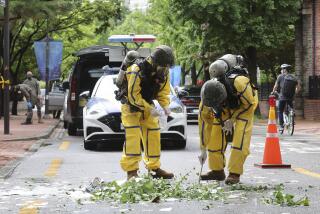South Korea activist’s protest on cargo crane to enter 8th month
Kim Jin-suk spends her days cloistered in a metallic cell 15 stories above the ground, solemnly watching the world scurry about far below.
The 51-year-old labor activist is a prisoner of choice. Since January, she has waged a solitary protest on Crane No. 85, a mammoth industrial apparatus, to condemn layoffs at a major South Korean shipping company in this southern port city.
For 211 days, she has focused attention on what she says are the excesses of the country’s corporate culture, in this instance the 400 job cuts announced by the bosses at Hanjin Heavy Industries & Construction last year.
On Jan. 6, the onetime shipyard welder sneaked onto the company’s seaside lot, scaling the machine’s long neck to take residence in the control room, a third of the way up.
Her face-off is playing out amid a teeming industrial yard where the work never stops. Kim described her prison tower as “smaller than the foyer in an apartment where people take their shoes off” — about 6 feet by 10 feet.
On hot days, temperatures in the windowless control room are nearly unbearable, she says. Her few possessions include a blanket and towel. She uses a bucket for a toilet, cannot wash or bathe, and is refused access to books or newspapers.
Meager meals of rice porridge and sweet potatoes, cooked by fellow activists, are hoisted up by bucket, but not before being checked by company security for contraband.
Her only outside contact comes via Twitter and a solar-powered cellphone, which she uses to talk with reporters and fellow activists. On cloudy days when she cannot recharge her batteries, she’s forced to pass the hours alone with her thoughts.
The strict diet and stress of her vigil have made her lose weight. Her face is gaunt. Her clothes now hang loosely. The company’s threat of a surprise raid, she says, keeps her awake.
“I am anxious all the time,” said Kim, who is single and works for the Korean Confederation of Trade Unions, a labor umbrella group.
She’s not the only one. The shipping company says her protest has cost time and money, but would not elaborate on the nature or size of the losses. On some weekends, thousands of sympathizers have waged protests that block traffic.
“She has nothing to do with our company, yet she has caused us a lot of harm,” said Jung Cheol-seong, a Hanjin spokesman. “The company image has suffered, domestically and internationally.”
Jung said the company has negotiated with 306 of the laid-off workers to accept a special retirement package, and hopes the remaining 94 will soon follow suit. In any event, he said, this is Hanjin’s business, not Kim’s.
Yet officials have been wary of negative publicity that might come with a raid to extract Kim. So their measures are subtle. In recent weeks, Hanjin began moving Crane No. 85 toward a more isolated spot farther inside the shipyard, but after a bit of progress, the move stopped.
This week, a company official scaled a ladder to reason with Kim, who later described the exchange on Twitter.
“Let’s have a talk on the ground,” he said. “If you don’t come down in a few days, we’ll install nets around you” and stage a raid.
“Did you come all the way up here just to say that?” she responded. “Just go back down.”
Experts say Kim’s protest highlights the mire of labor negotiations in a nation where unions are not a protected right and where the law does not force companies to bargain in good faith.
“In South Korea, even basic worker bargaining rights are not guaranteed,” said Cho Don-moon, a sociologist at Catholic University of Korea in Seoul.
Kim’s battle for workers’ rights has lasted decades. In 1986, she lost her welder’s job after employers objected to her union-organizing activities. She later became one of South Korea’s leading labor activists and wrote a book on her travails.
Then, just before dawn Jan. 6, she slipped onto the Hanjin yard and headed for Crane No. 85, the scene of what activists call a heartbreaking battle over a separate dispute several years ago.
In 2003, after waging a three-month vigil to protest working conditions, Kim Ju-ik, a 40-year-old father of three, hanged himself in the crane’s control room. His suicide note proclaimed, “This is a country where a laborer has to risk his life to live like a human.”
Kim Jin-suk has no intentions of suicide, instead vowing to stay put until workers win back their jobs.
On the ground, dozens of private security officers roam the fences around the yard, which have been buttressed by spirals of concertina wire.
For her protection, fellow activists monitor Kim’s movements via a camera in a nearby apartment building — footage that is broadcast on the Internet 24 hours a day.
In June, officials cut off electricity to the crane’s control room. Each day, as her body weakens, Kim says, she thinks of the deceased activist for the willpower to continue her protest.
“I am sitting at the place where Ju-ik sat. I sleep where Ju-ik slept and I see the last view of the world Ju-ik saw before passing away,” she wrote in a letter. “And I am going to do it, the thing that Ju-ik wanted to do so much but couldn’t do at last: Walk down the crane of my own free will.”
Choi is a news assistant in The Times’ Seoul bureau.
More to Read
Sign up for Essential California
The most important California stories and recommendations in your inbox every morning.
You may occasionally receive promotional content from the Los Angeles Times.










